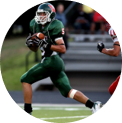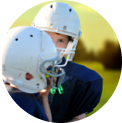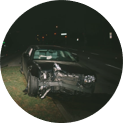CONCUSSIONS
WHAT IS A CONCUSSION?
It is estimated that 4-5 million concussions occur annually, making a concussion the most common type of traumatic brain injury. A concussion is a type of traumatic brain injury that changes the way your brain functions.

67% of the neural connections within the brain are involved with some aspect of vision, whether it is visual input, visual perception, or visual integration.
It’s no wonder that vision problems are so common after an acquired brain injury.

Fewer than 10% of sports-related concussions have associated loss of consciousness.
A review article in Pediatrics (2010) reiterates that losing consciousness is NOT required to define a concussion. The most common cause of concussions in children is sports, especially contact sports such as football, soccer, lacross, and hockey. In the vast majority of cases, there is no “blacking out.”

Having had one concussion makes you more susceptible to another
Repeated concussions can cause permanent damage.

Car accidents and falls are the most common cause of concussions in adults
Even what seems like a mild “bump on the head” can have drastic neurological effects, which end up making daily tasks such as reading or driving extremely difficult (if not impossible).
CONCUSSION-RELATED VISION PROBLEMS
Concussions can cause impairments to your functional vision skills. Aside from just being able to see a clear image, your functional visual skills are required for you to move, focus your eyes, and use them together to gather information from the world around you.
- Eye focusing – Your ability to see an object clearly (especially at near) and your ability to shift focus between objects at different distances.
- Eye teaming – Your ability to direct both eyes to fixate on the same object. The two images, one from each eye, are combined by your brain to give you depth perception.
- Eye movements – Your ability to fixate and follow a moving object and to switch fixation between objects.
In the retrospective study “Vision Therapy for Post Concussion Vision Disorders” (Gallaway et al, 2017), out of 218 patients diagnosed with a concussion and referred for a functional vision problem:
82%
of patients had an oculomotor disorder in one or more of the 3 categories:
CONCUSSION VISION SYMPTOMS
- Blurry Vision
- Double vision
- Dizziness
- Headaches
- Difficulty tracking objects
- Slow reading
- Difficulties with shifting gaze quickly from one point to another
- Focusing
- Loss of binocular vision (eye alignment)
- Eye strain
- Fatigue
- Glare, or light sensitivity
- Inability to maintain visual contact
- Increased sensitivity to visual motion
The extent of the injury can also impact a person’s visual information processing ability. This can cause the following symptoms:
- Spatial disorientation
- Difficulties with balance and posture
- Poor depth perception
- Reduced processing speed (ie. judging the speed of moving objects, people)
- Memory loss
- Poor handwriting
TREATMENT FOR POST-CONCUSSION VISION PROBLEMS
The good news is that many of the visual conditions that result from a concussion can be successfully managed by a doctor with both knowledge and experience in the areas of binocular vision, and vision therapy.
Following a Visual Skills Assessment, Dr. Lee will determine whether glasses, contact lenses, vision therapy, or a combination is best to address your needs.
Treatment for a functional vision problem resulting from a concussion will be different for every patient, and then length of treatment with also vary based on how many areas area affected and the severity.
The goal of vision therapy following a brain injury is to restore the patient’s visual function. As is typical with any type of rehabilitation following a brain injury, the outcome can sometimes be difficult to predict. Each case is unique, and we work hard to provide a customized treatment plan to address the patient’s needs and ensure the best possible outcome.
Back to Services

